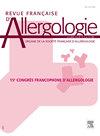对花生过敏。状态和前景,由GT2A。第一部分:花生过敏的流行病学和负担
IF 0.3
4区 医学
引用次数: 0
摘要
本文是一篇关于花生过敏的流行病学和负担的非系统综述。花生过敏是儿童中最常见的ige介导的食物过敏之一,根据ELFE队列的问卷调查,估计法国5.5岁儿童的患病率为0.9%。90%的花生过敏病例在3岁前开始,只有20%至25%的病例在成年前自行消退。在三分之二的病例中,花生过敏与对一种或多种其他豆类的过敏有关,有时还伴有交叉过敏。花生过敏患者通常伴有特应性合并症,尤其是哮喘。花生是最常见的过敏原之一,涉及严重甚至致命的食物过敏反应,并与过敏复发的高风险有关。花生过敏导致生活质量受损,并具有显著的社会心理影响。花生过敏的患者可能与其他食物过敏的患者有不同的表型。这些患者应考虑多学科护理和个性化治疗策略。本文章由计算机程序翻译,如有差异,请以英文原文为准。
L’allergie à l’arachide. État des lieux et perspectives, par le GT2A. Partie 1 : épidémiologie et fardeau de l’allergie à l’arachide
This article is a non-systematic review on the epidemiology and burden of peanut allergy. Peanut allergy is one of the most common IgE-mediated food allergies in children, with an estimated prevalence in France of 0.9% at the age of 5.5 years based on questionnaires from the ELFE cohort. Peanut allergy begins in 90% of cases before the age of 3 years and spontaneously regresses in only 20 to 25% of cases before adulthood. Peanut allergy is associated with sensitization to one or more other legumes in two thirds of cases, and sometimes with a cross-allergy. Patients with peanut allergy most often have associated atopic comorbidities, particularly asthma. Peanut is one of the most common allergens involved in severe and even fatal food anaphylaxis and is associated with a high risk of allergy recurrence. Peanut allergy leads to impaired quality of life and has a significant psychosocial impact. Peanut-allergic patients probably have a different phenotype than patients with other food allergies. Multidisciplinary care and a personalized treatment strategy should be considered in these patients.
求助全文
通过发布文献求助,成功后即可免费获取论文全文。
去求助
来源期刊

Revue Francaise d Allergologie
Medicine-Immunology and Allergy
自引率
33.30%
发文量
349
期刊介绍:
La Revue Française d''Allergologie : un véritable forum pour faire connaître des travaux originaux et permettre la diffusion de l''information auprès de toutes les spécialités concernées par les pathologies allergiques. La Revue Française d''Allergologie (8 numéros par an) est au carrefour de nombreuses spécialités - dermatologie, pédiatrie, ORL, pneumologie, ophtalmologie, médecine interne - qui, toutes, ont à traiter des maladies allergiques. Les symptômes des allergies fondés sur des mécanismes communs sont le plus souvent associés et se succèdent chez un même patient. En forte progression depuis 20 ans, les maladies allergiques sont dans l''attente de perfectionnements et d''avancées thérapeutiques qui permettront aux nombreux patients qui en sont atteints de mieux vivre avec leurs allergies. La Revue Française d''Allergologie se veut donc un véritable forum de discussions et d''échanges entre tous les spécialistes confrontés aux pathologies
 求助内容:
求助内容: 应助结果提醒方式:
应助结果提醒方式:


